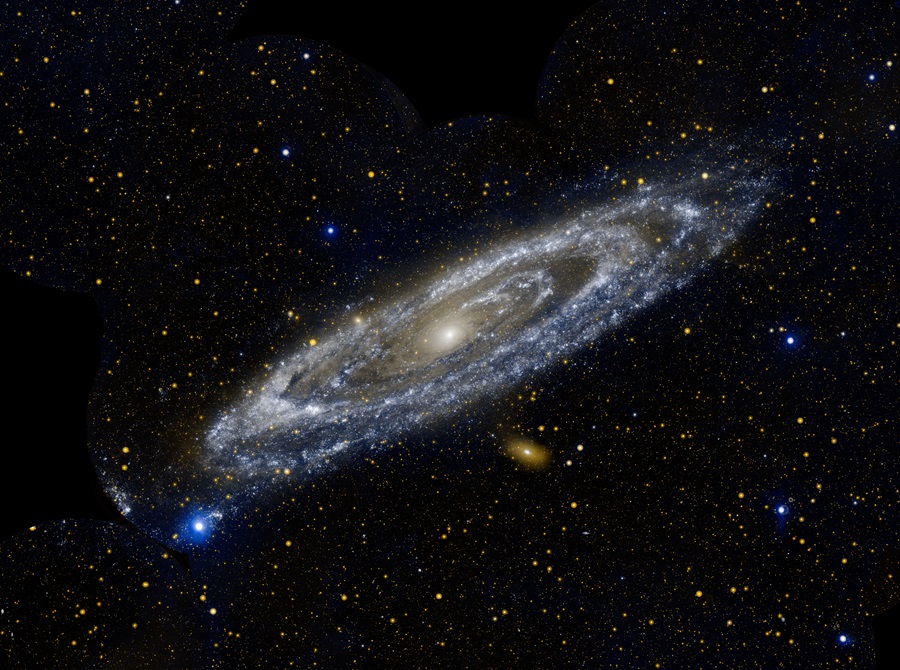Distances in space are enormous. Look up on any night and pick a star, any one you like. Then consider this: the sparkling light you see began its journey tens, hundreds, or even thousands of years ago. Even traveling at over 186,000 miles per second, a star’s light takes that much time to traverse the vast gulfs of space’s emptiness and reach your eyes.
Astronomers call the distance that light travels in one year (about 6 trillion miles) a light-year. It’s a unit that serves to measure both distance and, indirectly, time. To look at stars is to look into the past, seeing things as they were, not as they are now.
High overhead on these late summer and early autumn nights is the bright star Vega, a relatively close neighbor of Earth at 25 light-years away. Its light that you see tonight started on its way in 1999. There was no Facebook back then, and Y2K was a thing that people worried about. Deneb, another bright star near Vega and another member of the Summer Triangle, is 1,411 light-years away. We see it as it was in the early 7th century CE. At that time, the Dark Ages had descended on much of Europe, while in the Americas Mayan astronomers performed astonishing feats of calculation and prediction.

If you’d like to gaze even farther back in time, head outside early in the evening in late September or early October and look very low, a little west of south. You’ll need a clear view to the horizon — harbors and beaches on the Outer Cape’s bay side are usually ideal for low-elevation views to the south and west. We’re looking for the constellation Sagittarius, the Archer. A star map (book or app) and a little preparation before going outside will help you find it. The shape of the Archer himself is not so obvious. But within Sagittarius is an asterism (an informal grouping of stars) called the Teapot that’s distinctive; it looks just like a teapot, tipped on its side to pour.
Once you’ve found the Teapot and it’s fully dark outside, give your eyes some more time to adapt to the dark. The Milky Way should become apparent. You’ll see a diffuse white glow surrounding Sagittarius, arcing up and left to the east, then fading away in the northeast. That ghostly glow is the combined light of countless stars too far away for our eyes to resolve individually.
The Milky Way is our home galaxy, a grand spiral consisting of about a trillion stars gravitationally bound and orbiting a common center. Our Sun is one of those stars, located in one of the Milky Way’s spiral arms. When you look toward Sagittarius, you look edge-on toward the heart of our galaxy, some 26,000 light-years away, where stars crowd much closer together than they do here in the spiral arms. That’s why the Milky Way appears thickest and brightest around Sagittarius.
Gaze through Sagittarius to the heart of the Milky Way and you gaze 26,000 years into the past. The Outer Cape was a pile of rubble at the edge of a glacier hundreds of feet thick and just beginning to melt and retreat. No people lived here yet. Humanity had not yet invented agriculture or writing. But we did look up at the stars and tell stories of what we imagined we saw there.
If you feel overwhelmed by such cosmic distances and time frames, the night sky offers some solace this autumn. Look to the southeast after dark. You’ll see a yellow-gold star shining brightly. That’s Saturn. (It will move progressively south through October, then into the southwest through November and December.)
Saturn is a planet in our solar system, the family of objects (planets, asteroids, and comets) that orbits the Sun as it, in turn, orbits the Milky Way. Saturn is well known for its beautiful rings and is a huge planet, almost 10 times the size of Earth. You may have heard about Saturn in the news recently; it reached opposition on Sept. 8. At opposition, the planet is closest to Earth and appears bigger and brighter than at other times.
How close is close? If you liken the Milky Way to a country and its center to a densely populated city, then the spiral arm where we reside is a modest suburb. And within that suburb you’ll find our solar system on a quiet, unremarkable street. Our next-door neighbors to either side are Venus (25 million miles away) and Mars (140 million miles). Farther out from Mars is Jupiter at 440 million miles. Then there’s Saturn, on average about 800 million miles from us.
That might still seem very far away. But contrast Saturn’s distance from us with the next star closest to us, Proxima Centauri at 4.24 light-years away. Saturn is a mere 85 light-minutes from us. That is, it takes light 85 minutes to speed from Saturn to Earth. And if you’d like to gaze at something truly next door, consider the Moon the next time you see it. It’s only 220,000 miles away — that’s just 1.2 light-seconds. Celestial objects don’t get any closer than that; nor do we want them to. Just ask the dinosaurs. Clear skies!



